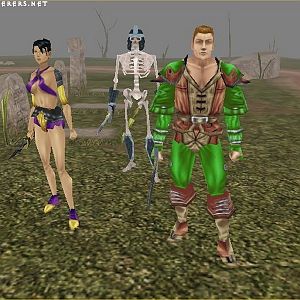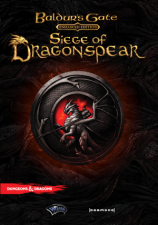-

- Forums
- Chatrooms
- Gallery
- Gameplay Videos
- Upload
- Articles
- Mod Reviews
- Shop SP: Games, Movies, Books

|
Frequently
Asked Questions
|
Q: I've
heard of Pool of Radiance before, is this a different game?
A: Yes, it's a sequel. The original Pool of Radiance launched in 1987
and was first D&D game on a computer to use the Advanced Dungeons
& Dragons game license. It was followed by 12 titles, often referred
to as the "gold box series". This release of Pool of Radiance
will take up the story 10 years after the old one ended. A new Pool of
Radiance has been discovered and your novice party of heroes will be dispatched
to uncover the source of the new evil. No knowledge of the prior PoR game
is required to enjoy this sequel, but it should be a lot of fun for the
many fans of the original.
Q: Who
is developing/publishing Pool of Radiance: Ruins of Myth Drannor (PoR)?
A: POR is being developed at Stormfront Studios and published by Ubi Soft
Entertainment under the SSI brand. Stormfront has been associated with
SSI's classic "gold box" RPG offerings such as: Gateway to the
Savage Frontier, Treasures of the Savage Frontier and the original Neverwinter
Nights on AOL.
Q: What
engine is PoR using?
A: A new engine from Stormfront, using a state-of-the-art character animation
system.
Q: What
rules system is PoR using?
A: PoR will be the first D&D RPG to use the 3rd Edition
D&D Rules. The new rules set has been made available at GenCon in
August of 2000.
Q: Where
is PoR set, exactly?
A: PoR is set in the Moonsea region of the Forgotten Realms, and starts
in the port city of New Phlan, the original site of the first Pool of
Radiance. From there, the characters go to the ancient elven city of Myth
Drannor, located in the forest kingdom of Cormanthor.
Q: How
many areas will we have to explore?
A: Aside from the tutorial section in New Phlan, the section of Myth Drannor
that the characters explore contains several very large sub-dungeons.
Some locations have towers, overhead walkways, mystical teleportation
devices, and more.
Q: What
are they like?
A: Myth Drannor was the first city where many of the races were able to
co-exist peacefully, so there are several different environments in which
to adventure: the once-majestic towers of the elven Castle of Cormanthyr,
mysterious forested glades that were once a part of the city, and a dwarven
stronghold called the "House of Gems," to name a few. Also,
we've taken all of the maps of Myth Drannor that we could find and built
a 3D map of the city from the ground up. For all intents and purposes,
we have buildings that are accuracte in every way to the D&D information
we have.
Q: How
many new NPCs can we get?
A: You can create 1-4 characters to begin the game, and can have up to
six characters in your party with NPCs that you meet along the way. Once
an NPC joins your party, he or she is under your control.
Q: Is
there an XP cap?
A: Based on the new 3rd Edition Rules, PoR is designed to allow your characters
to progress from first level all the way up to sixteenth in any one class
(this allows spellcasters to cast up to 8th level spells). Players can
multiclass to a maximum to 16/16 or any combination thereof that does
not exceed level 16 in any one class. For example, a character could become
a 16th level rogue / 16th level sorcerer, or a 10th level barbarian, with
5 levels in cleric, 12 levels in ranger, and 5 levels in monk.
Q: What
are the races and classes?
A: We are supporting the basic Classes and Races per the new 3rd
Edition Rules: Fighter, Barbarian, Paladin, Ranger, Cleric, Sorcerer,
Monk, and Rogue. Races we'll support are Half-Orc, Human, Halfling, Dwarf,
Elf, and Half-Elf. This is not to say that these are all of the races
in the game; we'll have Drow NPCs and other races as well.
Q: Are
there going to be new magic items?
A: Yes. In fact, Myth Drannor is rumored to be quite a storehouse of magic
items. Many of the magic items that the player can find in PoR are ones
that are familiar from the Forgotten Realms, others are new, unique, items
that may surprise the player.
Q: Are
there going to be new spells & monsters?
A: Yes. There will be over 100 spells, some of them will be new 3rd Edition
spells and others will be the traditional spells. We have a wide variety
of monsters and some are straight from the pages of the new Player Handbook
for D&D. We even invented a new creature called the Arraccat for players
to face, which is sort of a combination of a spider, scorpion, and a lion
with a nasty temper.
Q: When
will Pool of Radiance: Ruins of Myth Drannor be released?
A: The game will hit the shelves of USA in the end of September 2001.
The rest of the world will have to wait till mid-November 2001.
Q & A with Pool of Radiance Producer Chuck Yager
Q: How
has using the 3rd edition rules changed PoR?
A: Drastically! Originally the game started off as a 2nd Edition product
as the 3rd Edition rules hadn't been announced yet. After we made arrangements
with Wizards of the Coast to get copies of the rules, we immediately started
re-shaping the game to conform as best we could. Naturally, we already
had a significant code structure in place, and while we were able to implement
nearly all of the new rules, certain changes just didn't make sense for
our game or work within the code. However, the bulk of changes earned
the game the title of being the first RPG to show off the new 3E rules.
We have everything from concealment and cover in combat, to delaying and
refocusing your initiative, to brand new magical items, skills, feats,
and special class abilities for players to use at their disposal.
Q: Will
the NPCs ever do their own thing? Do members of your party interact? Why
a mandatory two slots for NPCs?
A: Throughout the course of the game, you run across a total of 8 NPCs
that will join your party and a host of others that won't. It is up to
you whether or not you let them join up; if you changed your mind, they
can usually be found later on in sections of the game. As for doing their
own thing, some NPCs have their own agendas, but if they are in your party,
they are doing your thing. We didn't want to create conflict within the
party nor confusion about which mission was more important. We left two
slots open for NPCs to give the player the chance to try out some different
characters if they wished… After all, you might decide you rather
like the sorcerer/fighter more than your ranger and want to swap them
out.
Q: Is
Pool of Radiance turn-based or real-time?
A: It's turn-based style gaming with a controllable twist. The turn times
are adjustable. You can set them for unlimited time, which is the most
like traditional D&D gaming or for as little as 6 seconds. At fastest
setting each character will have no more than 6 seconds to react, and
if the turn is not taken, the game will move to the next character.
Q: How
long (approximately) is the game play?
A: For most people it will take a minimum of 100 hours to get through
the entire game.
Q: Is
the multi-player game different than single player?
A: Yes, the multi-player mode is more hack and slash adventuring and features
Random Dungeons.
Q: Since
Sorcerers are going to be the mages of the game how are you handling their
spells? Are you putting the normal limit of 4-5 spells per level on them
or will they get a spell book much like a wizard's and have free run of
those?
A: Sorcerers are handled exactly as they are in 3rd Edition. They get
new spell slots as they go up in levels and can cast any spell they know
as many times as they have slots in that spell magnitude. Every time a
sorcerer gains a level where they would learn a new spell, an interface
screen pops up giving the remaining spells of that magnitude that they
can choose from.
Q: What
is your favorite aspect of the look or feel of the game?
A: I still come back to the character models themselves. Sure the backgrounds
are beautiful and the monsters are engaging, but the actual characters
themselves move, breathe, run and look more alive than any other RPG I
have seen thus far. I personally love the half-orc, who stands 8 ft. (and
which we measured against the other races in the scale of the game to
keep accurate) and can wield the largest weapons with ease; dress him
up in some plate mail and you've got a big issue on your hands! A second
thing that I am enamoured with is the spell visuals in game… It just
seems to add more flare to the fireball when it trails smoke behind it
and sends sparks shooting up when it detonates.
Some Special Comments from the Producer regarding the 3rd Edition Rules New 3E Elements in PoR:RoMD
By now most of you already know the bulk of what is in PoR:RoMD as far as 3rd Edition rules go. It's been no secret for some time now as we've drawn closer to the end of the project. But for those of you who are new to the site, or for others who strictly want to reference some of the different rules we are implementing, I've compiled a list of most notable mechanics from 3E D&D that have made it into the product. Here goes:
Combat
Features:
Concealment modifiers
Cover bonuses
Defensive Fighting
Delay
Favored Enemies for rangers
Flanking
Full Attack option
Line of Sight
Rage for barbarians
Ranged Weapon modifiers for extreme distance
Refocus
Smite Evil for paladins
Sneak Attack for rogues
Turn Undead for clerics
Skills:
Concentration
Disable Device
Heal
Hide
Listen
Move Silently
Open Locks
Search
Spellcraft
Spot
Feats:
Blind Fighting
Cleave
Combat Casting
Combat Reflexes
Great Fortitude
Improved Critical
Improved Initiative
Iron Will
Lightning Reflexes
Mobility
Point Blank Shot
Power Attack
Precise Shot
Run
Skill Focus
Spell Penetration
Toughness
Spells:
Over 100 spells including new ones such as Divine Power (cleric), Cat's
Grace (sorcerer), Searing Light (cleric), Repulsion (sorcerer), and Shield
of Faith (cleric).


